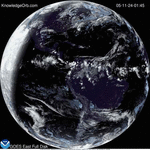The Chemistry and Camera (ChemCam) instrument on NASA’s Mars rover Curiosity was used to check the composition of gray tailings from the hole in rock target “Cumberland” that the rover drilled on May 19, 2013. This image taken by the rover’s Mast Camera during the mission’s 281st Martian day, or sol, (May 21, 2013) shows a row of small pits created by firing the ChemCam’s laser at the tailings. The pits are near the drill hole, which has a diameter of about 0.6 inch (1.6 centimeters).
The Curiosity Rover continues to do well and is operating normally. It’s work done in Mars’ Gale Crater, where it has been since last summer, it will soon change modes to a distance-driving mode headed for an area about 5 miles (8 kilometers) away, at the base of Mount Sharp.
“We’re hitting full stride,” said Mars Science Laboratory Project Manager Jim Erickson of NASA’s Jet Propulsion Laboratory, Pasadena, Calif. “We needed a more deliberate pace for all the first-time activities by Curiosity since landing, but we won’t have many more of those.”
No additional rock drilling or soil scooping is planned in the “Glenelg” area that Curiosity entered last fall as the mission’s first destination after landing. To reach Glenelg, the rover drove east about a third of a mile (500 meters) from the landing site. To reach the next destination, Mount Sharp, Curiosity will drive toward the southwest for many months.
“We don’t know when we’ll get to Mount Sharp,” Erickson said. “This truly is a mission of exploration, so just because our end goal is Mount Sharp doesn’t mean we’re not going to investigate interesting features along the way.”








